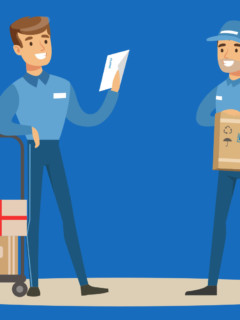Returns and exchanges of goods are an integral part of the shopping experience, especially in the case of e-commerce. Efficient and effective management of these processes is key to building trust and customer loyalty. Appropriate packaging plays an important role in this, enabling easier, safer and more environmentally friendly returns.
How to prevent returns?
Damage to goods in transit is one of the main causes of returns, so a key element in preventing this problem is choosing the right packaging for shipping. A well-chosen type of packaging can significantly reduce the risk of damage to the product during its journey from the warehouse to the customer. What is worth bearing in mind when choosing packaging?
First and foremost, its size, which should not be significantly larger than the item being shipped. It is also important to additionally secure the goods, e.g. by using fillers such as bubble wrap. This way you can be sure that the product will not move during transport.
It is also worth remembering to use protective tape to keep the package tightly closed. The packaged item should arrive intact to the customer.
Although robust packaging reduces the likelihood of returns, they cannot be completely eliminated. Sometimes customers abandon a purchase after the transaction has already been completed or want to exchange an item because it does not fit properly. This often happens, for example, with garments that may be the wrong size.
What then? It is worth ensuring that the return or exchange process goes smoothly.
How can you make the returns and exchanges process easier?
What can you do to make sure that the return or exchange process goes smoothly and with the least possible effort on the part of the customer?
Using the right packaging
The returns and exchanges process should be as customer-friendly as possible, so it is important that the packaging is easy to use. In this case, the cardboard box, which can be considered universal packaging, will work best, as it can accommodate items of different sizes or shapes.
It is also worth looking out for boxes with convenient fasteners or clips, which make it easy to fill the packaging and ensure a secure closure. Additionally, cartons with automatic bottoms or packaging with a self-closing system can prove more convenient for customers, eliminating the need for adhesive tape or other additional materials.
Personalisation and easier identification
Personalisation of packaging is vital in effectively managing the returns and exchanges process. Placing an individual barcode or QR tag on the packaging can make it significantly easier for a company to identify and track returns. This allows warehouse staff to quickly locate and scan returned products, speeding up the process of reintegration into the warehouse and enabling faster processing of returns.
Additionally, packaging with individual customer information, such as address details or order number, can significantly improve the accuracy of return delivery. With this information, logistics staff can be sure that the product is returning to the correct warehouse or branch office, reducing the risk of confusion and making it easier for the customer to track the status of the return.
Reusable packaging
Using reusable packaging eliminates the need to constantly produce and consume new packaging. Instead of throwing away the packaging they receive upon receipt, customers can reuse it for returns or exchanges. This is particularly beneficial as it reduces the amount of packaging waste generated by e-commerce.
Furthermore, using the same packaging many times also reduces costs for both customers and companies. Customers do not have to incur the additional costs of purchasing new packaging for returns, which can be particularly important if returns are frequent. In turn, companies save on packaging and production costs, which translates into lower operating costs.
In addition, reusable packaging promotes the efficient use of resources. Each pack can be used multiple times, reducing the need for new raw materials and the energy required to produce disposable packaging.
Easy return means greater customer satisfaction
The right packaging plays a key role in return and exchange processes, affecting both the customer experience and the operational efficiency of companies. Safe, easy-to-use and environmentally friendly packaging can significantly facilitate the management of returns and exchanges, while contributing to increased customer confidence and business sustainability. After all, no one likes the hassle of packing and posting parcels, especially those that are sent back to the retailer.
You may also be interested in: What are the best inventory management strategies for speed of delivery?














